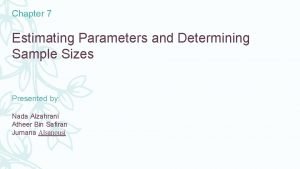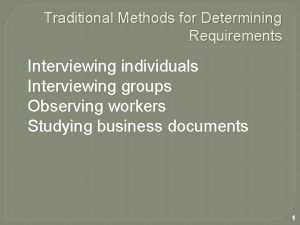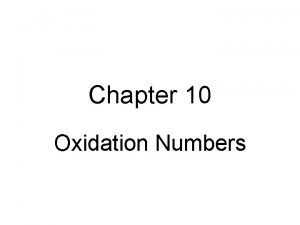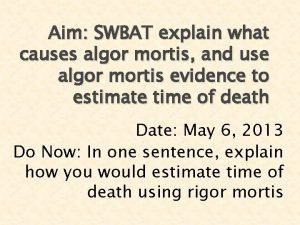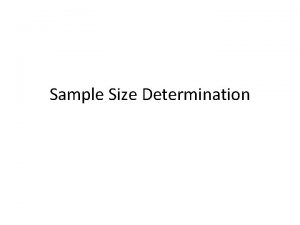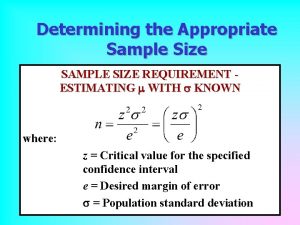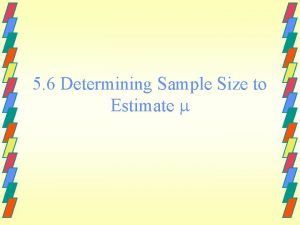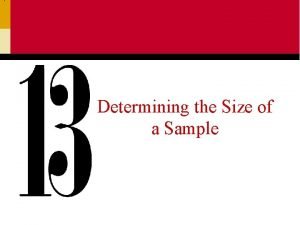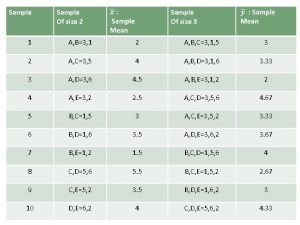Determining Sample Size The required sample size can








- Slides: 8

Determining Sample Size § The required sample size can be found to reach a desired margin of error (e) with a specified level of confidence (1 - ) § The margin of error is also called sampling error § the amount of imprecision in the estimate of the population parameter § the amount added and subtracted to the point estimate to form the confidence interval Statistics for Managers Using Microsoft Excel, 5 e © 2008 Pearson Prentice-Hall, Inc. Chap 8 -1

Determining Sample Size § To determine the required sample size for the mean, you must know: § The desired level of confidence (1 - ), which determines the critical Z value § The acceptable sampling error (margin of error), e § The standard deviation, σ Now solve for n to get Statistics for Managers Using Microsoft Excel, 5 e © 2008 Pearson Prentice-Hall, Inc. Chap 8 -2

Determining Sample Size If = 45, what sample size is needed to estimate the mean within ± 5 with 90% confidence? So the required sample size is n = 220 Statistics for Managers Using Microsoft Excel, 5 e © 2008 Pearson Prentice-Hall, Inc. Chap 8 -3

Class Exercise Statistics for Managers Using Microsoft Excel, 5 e © 2008 Pearson Prentice-Hall, Inc. Chap 8 -4

Class Exercise Statistics for Managers Using Microsoft Excel, 5 e © 2008 Pearson Prentice-Hall, Inc. Chap 8 -5

Class Exercise Statistics for Managers Using Microsoft Excel, 5 e © 2008 Pearson Prentice-Hall, Inc. Chap 8 -6

Applications in Auditing § Six advantages of statistical sampling in auditing § Sample result is objective and defensible § Based on demonstrable statistical principles § Provides sample size estimation in advance on an objective basis § Provides an estimate of the sampling error Statistics for Managers Using Microsoft Excel, 5 e © 2008 Pearson Prentice-Hall, Inc. Chap 8 -7

Applications in Auditing § Can provide more accurate conclusions on the population § Examination of the population can be time consuming and subject to more nonsampling error § Samples can be combined and evaluated by different auditors § Samples are based on scientific approach § Samples can be treated as if they have been done by a single auditor § Objective evaluation of the results is possible § Based on known sampling error Statistics for Managers Using Microsoft Excel, 5 e © 2008 Pearson Prentice-Hall, Inc. Chap 8 -8
 Estimating parameters and determining sample sizes
Estimating parameters and determining sample sizes Agitation method involves brushing
Agitation method involves brushing How can ngt be used for requirements determination?
How can ngt be used for requirements determination? Determining the arrival times between p-wave and s-wave
Determining the arrival times between p-wave and s-wave Polymer molecular weight determination
Polymer molecular weight determination How to determine the rate determining step
How to determine the rate determining step Chapter 18:5 determining net income
Chapter 18:5 determining net income Oxidation number
Oxidation number What causes algor mortis?
What causes algor mortis?
